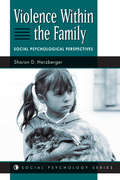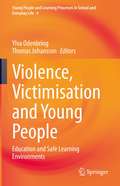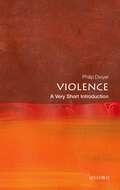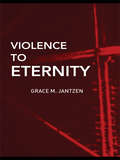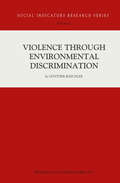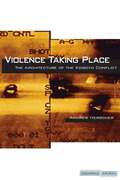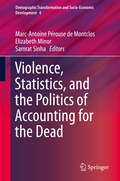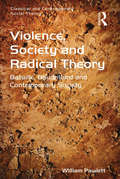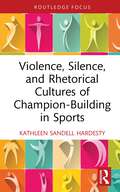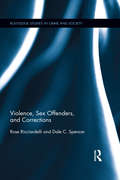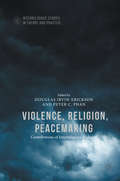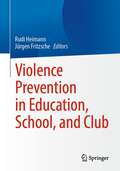- Table View
- List View
Violence Within The Family: Social Psychological Perspectives
by Sharon D HerzbergerHerzberger connects the study of child, partner, sibling, and elderly abuse to the varied disciplinary perspectives of social psychology. She addresses aggression, the consequences of this type of violence, and prevention and treatment strategies. This book is appropriate for course use in criminal justice, family systems, public policy, psychology
The Violence Within: Cultural And Political Opposition In Divided Nations
by Kay B. WarrenThis book explores a range of contemporary conflicts in which culture has become an explicit issue: ethnic nationalism, religious fundamentalism, the militarization of civilian life, opposition movements in authoritarian states, political resistance to redistributive reforms, and racism in racial democracies. The authors show that one cannot understand current conflicts or crises without studying long-term patterns of social, political and cultural change. At issue throughout the book is how anthropologists and comparative political scientists conceptualize the interplay of culture and politics. The result is a volume that offers readers a sophisticated introduction to new currents in cultural analysis, demonstrates realms of convergence and continuing debate between the two disciplines, and offers focused analyses of contemporary conflicts from the perspective of those caught up in them. The case studies for this volume focus on communities and movements in Guatemala, Brazil, Israel, Iran, Egypt, South Africa, the Philippines and Northern Ireland.
The Violence Within: Cultural And Political Opposition In Divided Nations
by Kay B. WarrenThis book explores a range of contemporary conflicts in which culture has become an explicit issue: ethnic nationalism, religious fundamentalism, the militarization of civilian life, opposition movements in authoritarian states, political resistance to redistributive reforms, and racism in racial democracies. The authors show that one cannot understand current conflicts or crises without studying long-term patterns of social, political and cultural change. At issue throughout the book is how anthropologists and comparative political scientists conceptualize the interplay of culture and politics. The result is a volume that offers readers a sophisticated introduction to new currents in cultural analysis, demonstrates realms of convergence and continuing debate between the two disciplines, and offers focused analyses of contemporary conflicts from the perspective of those caught up in them. The case studies for this volume focus on communities and movements in Guatemala, Brazil, Israel, Iran, Egypt, South Africa, the Philippines and Northern Ireland.
Violence, Victimisation and Young People: Education and Safe Learning Environments (Young People and Learning Processes in School and Everyday Life #4)
by Ylva Odenbring Thomas JohanssonThis edited collection focuses on different aspects of everyday violence, harassment and threats in schools. It presents a number of in-depth studies of everyday life in schools and uses examples and case studies from different countries to fuel a discussion on national differences and similarities. The book discusses a broad range of concepts, findings and issues, under the umbrella of three main themes: 1) Power relations, homosociality and violence; 2) Sexualized violence and schooling; and 3) Everyday racism, segregation and schooling. Specific topics include sexuality policing, bullying, sexting, homophobia, and online rape culture. The school is young people’s central workplace, and therefore of great importance to students’ general feeling of wellbeing, safety and security. However, there is no place where youth are at greater risk of being exposed to harassment and violations than at school and on their way to and from school. Threats are a relatively common experience among school students, but some aspects of these mundane and frequent harassments and violations are not taken seriously and are, therefore, not reported. Harassment and violations often have negative effects on youth and children, and increase their risks of such adverse outcomes as school dropout, drug use, and criminal behaviour. Contemporary research has shown that gender is of great importance to how students handle and report, or do not report, various violent situations. Studies have also revealed how the notions of masculinity and of being a victim can be conflicting identities and affect how students handle situations of threat, violence and harassment. The importance of gender is also particularly evident with regard to sexual harassment. Female students generally report greater exposure to sexual harassment than male students do.
Violence: A Very Short Introduction (Very Short Introductions)
by Philip DwyerVery Short Introductions: Brilliant, Sharp, Inspiring Violence is part and parcel of human history and of human nature. It is one of our most distinctive traits, the one thing that all cultures and societies, across time, share in common. It has defined not only the ways in which individuals relate to each other, but also how collective entities and states have interacted with each other over the millennia. All societies are violent and all individuals have the capacity for violence. However, not all societies and not all individuals are equally violent, and nor does violence exist with the same intensity across cultures. This Very Short Introduction examines the more visible, physical acts of violence - interpersonal, gendered, collective, religious, sexual, criminal, and political - in the modern world. It explores how violence in the pre-modern world was different from the modern world, and what is significant about those differences. It also discusses what violence is by examining understandings of the ideas, values, and cultural practices embedded in an act of violence, and considering acts of violence as the outcome of a process dependent on the cultural context in which they take place. Along the way Dwyer considers some core questions, asking whether violence is always 'bad', and if there are any limits to human violence? Why is it that what was once considered acceptable - wife beating, duelling, slavery - at some point becomes unacceptable in some societies and cultures, and yet continues in others? And finally, are we becoming more or less violent? ABOUT THE SERIES: The Very Short Introductions series from Oxford University Press contains hundreds of titles in almost every subject area. These pocket-sized books are the perfect way to get ahead in a new subject quickly. Our expert authors combine facts, analysis, perspective, new ideas, and enthusiasm to make interesting and challenging topics highly readable.
Violence: A Very Short Introduction (Very Short Introductions)
by Philip DwyerVery Short Introductions: Brilliant, Sharp, Inspiring Violence is part and parcel of human history and of human nature. It is one of our most distinctive traits, the one thing that all cultures and societies, across time, share in common. It has defined not only the ways in which individuals relate to each other, but also how collective entities and states have interacted with each other over the millennia. All societies are violent and all individuals have the capacity for violence. However, not all societies and not all individuals are equally violent, and nor does violence exist with the same intensity across cultures. This Very Short Introduction examines the more visible, physical acts of violence - interpersonal, gendered, collective, religious, sexual, criminal, and political - in the modern world. It explores how violence in the pre-modern world was different from the modern world, and what is significant about those differences. It also discusses what violence is by examining understandings of the ideas, values, and cultural practices embedded in an act of violence, and considering acts of violence as the outcome of a process dependent on the cultural context in which they take place. Along the way Dwyer considers some core questions, asking whether violence is always 'bad', and if there are any limits to human violence? Why is it that what was once considered acceptable - wife beating, duelling, slavery - at some point becomes unacceptable in some societies and cultures, and yet continues in others? And finally, are we becoming more or less violent? ABOUT THE SERIES: The Very Short Introductions series from Oxford University Press contains hundreds of titles in almost every subject area. These pocket-sized books are the perfect way to get ahead in a new subject quickly. Our expert authors combine facts, analysis, perspective, new ideas, and enthusiasm to make interesting and challenging topics highly readable.
Violence, Utopia and the Kingdom of God: Fantasy and Ideology in the Bible
by George Aichele Tina PippinThis controversial book explores the presence of the fantastic in Biblical and related texts, and the influence of Biblical traditions on contemporary fantasy writing, cinema, music and art.The contributors apply a variety of critical concepts and methods from the field of fantasy studies, including the theories of Tolkien, Todorov, Rosemary Jackson and Jack Zipes, to Biblical texts and challenge theological suppositions regarding the texts which take refuge in science or historiography.Violence, Utopia and the Kingdom of God presents a provocative and arresting new analysis of Biblical texts which draws on the most recent critical approaches to provide a unique study of the Biblical narrative.
Violence, Utopia and the Kingdom of God: Fantasy and Ideology in the Bible
by Tina Pippin George AicheleThis controversial book explores the presence of the fantastic in Biblical and related texts, and the influence of Biblical traditions on contemporary fantasy writing, cinema, music and art.The contributors apply a variety of critical concepts and methods from the field of fantasy studies, including the theories of Tolkien, Todorov, Rosemary Jackson and Jack Zipes, to Biblical texts and challenge theological suppositions regarding the texts which take refuge in science or historiography.Violence, Utopia and the Kingdom of God presents a provocative and arresting new analysis of Biblical texts which draws on the most recent critical approaches to provide a unique study of the Biblical narrative.
Violence, Trauma, and Trauma Surgery: Ethical Issues, Interventions, and Innovations
by Mark Siegler Selwyn O. RogersThis unique and innovative title offers a comprehensive exploration of the intersection of ethics, violence, trauma, and trauma surgery. Underscoring that the causes of violence include a wide range of socioeconomic factors, including poverty and the lack of economic opportunity, and that violence often occurs in impoverished and underserved communities, various authors from a wide range of disciplines outline how intentional violence toward another person is multidimensional and complex. Many of the authors use Chicago as a framework for their chapter discussion, but there are similarities in many urban settings throughout the United States and abroad. Part I of the book, Ethical Issues Related to Violence, includes seven chapters that examine ethical issues related to violence. Each of these chapters discusses a different but intersecting aspect of how violence challenges ethical standards in medicine and health. Part II, Ethical Issues Related to Trauma and Trauma Surgery, offers eight chapters that address various aspects of ethical issues related to trauma and trauma surgery. Part III, Additional Concerns Relating to Violence and Trauma, describe a series of issues relating to violence and trauma, including surgical procedures, psychological distress, and geographic disparities in access to trauma care. Developed by nationally renowned thought leaders in the field, Violence, Trauma, and Trauma Surgery is a major and novel contribution to the clinical literature and will be of great interest to all physicians, clinicians, researchers, social scientists, students, policymakers, hospital administrators and community leaders concerned with understanding and improving outcomes relating to violence, trauma, and trauma surgery.
Violence to Eternity (Death and the Displacement of Beauty)
by Grace M. JantzenIn this volume Grace M. Jantzen continues her groundbreaking analysis of death and beauty in western thought by examining the religious roots of death and violence in the Jewish and Christian tradition, which underlie contemporary values. She shows how man’s fear of the female is often implicated in religious violence and in her critique of the Hebrew Bible and the Christian New Testament she examines a range of themes that show the western preoccupation with necrophilia. She examines the relation of death to the Jewish covenant, the nature of monotheism, Holy War and the Christian covenant and kingdom. However, Jantzen recognises that submerged beneath these themes in Judaism and Christianity are traces of an alternative world of beauty and life. Jantzen’s internationally recognised feminist philosophy of religion puts forward a powerful analysis of patriarchy and violence and reveals the hidden power of natality. Her work is a searching challenge for our times and one that gives hope in a violent world. This work is the first of two posthumous publications to complete her impressive genealogy death and beauty of western thought.
Violence to Eternity (Death and the Displacement of Beauty)
by Grace M. JantzenIn this volume Grace M. Jantzen continues her groundbreaking analysis of death and beauty in western thought by examining the religious roots of death and violence in the Jewish and Christian tradition, which underlie contemporary values. She shows how man’s fear of the female is often implicated in religious violence and in her critique of the Hebrew Bible and the Christian New Testament she examines a range of themes that show the western preoccupation with necrophilia. She examines the relation of death to the Jewish covenant, the nature of monotheism, Holy War and the Christian covenant and kingdom. However, Jantzen recognises that submerged beneath these themes in Judaism and Christianity are traces of an alternative world of beauty and life. Jantzen’s internationally recognised feminist philosophy of religion puts forward a powerful analysis of patriarchy and violence and reveals the hidden power of natality. Her work is a searching challenge for our times and one that gives hope in a violent world. This work is the first of two posthumous publications to complete her impressive genealogy death and beauty of western thought.
Violence Through Environmental Discrimination: Causes, Rwanda Arena, and Conflict Model (Social Indicators Research Series #2)
by Günther BaechlerSince all-out interstate wars for the time being seem to belong to the past, con flict studies focus more and more on domestic conflicts. This is a broad field, not only because the arbitrary line between war and sub-war violence disap pears and the analyst is confronted with phenomena reaching from criminal violence and clashes between communities to violent conflicts of long duration and civil wars with massacres and genocides as their characteristics. It is also because there are so many different types of conflicts to be analyzed, so many different types of behavior to be studied, whereas there is often little informa tion available on what is really going on. Against the background of internal conflicts, which tend to be as protracted as diffuse in terms of time, intensity, actors, and their goals, this study aims to follow a specific pathway through the current thicket of violent circumstances. It focuses on causation patterns by exploring the causal role of the environ mental factor in the genesis of violent conflicts occurring today and probably even more so tomorrow. This approach, which for once does not focus on a specific level of the conflict system, on one area in the conflict geography, or on a specific category of actors, analyzes causation dynamics.
Violence Taking Place: The Architecture of the Kosovo Conflict (Cultural Memory in the Present #440)
by Andrew HerscherWhile the construction of architecture has a place in architectural discourse, its destruction, generally seen as incompatible with the very idea of "culture," has been neglected in theoretical and historical discussion. Responding to this neglect, Herscher examines the case of the former Yugoslavia and in particular, Kosovo, where targeting architecture has been a prominent dimension of political violence. Rather than interpreting violence against architecture as a mere representation of "deeper" social, political, or ideological dynamics, Herscher reveals it to be a form of cultural production, irreducible to its contexts and formative of the identities and agencies that seemingly bear on it as causes. Focusing on the particular sites where violence is inflicted and where its subjects and objects are articulated, the book traces the intersection of violence and architecture from socialist modernization, through ethnic and nationalist conflict, to postwar reconstruction.
Violence, Statistics, and the Politics of Accounting for the Dead (Demographic Transformation and Socio-Economic Development #4)
by Marc-Antoine Pérouse de Montclos Elizabeth Minor Samrat SinhaThis book examines the methodological problems of accounting for the dead in armed conflicts as well as how the process itself is open to manipulation and controversy. Inspired by the work of the International Practitioner Network of casualty recording organizations, the book features thematic analysis, case studies and historical discussion on the use of the body count towards political, humanitarian and military ends.The book begins with a strategic analysis of the body count that introduces a general discussion on the measurement of war violence; its treatment by the media, humanitarian organizations, governments and the military; and its legal and political implications. It then examines the accounting for civilian war casualties in past and future conflicts, investigates the way the International Committee of the Red Cross has dealt with the issue of missing persons and the identification of dead bodies in armed conflicts and explores the role of statistics in aid policy debates, especially in regards to humanitarian workers.Next, the book details the field of casualty recording as practiced by civil society organizations, with insights from a study of 40 practitioners. It also features narrative case studies that detail the ways human losses were documented during recent conflicts in Northeastern India (2006-2009) and Croatia (1991-1995). In addition, one case study looks at the usefulness of casualty recording in engaging policymakers on the impacts of particular technologies of violence.This book offers an insightful investigation into violence, statistics and the politics of accounting for the dead. It will appeal to a broad audience of policy-makers, human rights activists, humanitarian practitioners as well as academics.
Violence, Society and Radical Theory: Bataille, Baudrillard and Contemporary Society (Classical and Contemporary Social Theory)
by William PawlettShedding light on the relationship between violence and contemporary society, this volume explores the distinctive but little-known theories of violence in the work of Georges Bataille and Jean Baudrillard, applying these to a range of violent events - events often labelled ’inexplicable’ - in order to show how even the most extreme of acts can be seen as socially meaningful. The book offers an understanding of violence as fundamental to social relations and social organisation, departing from studies that focus on individual offenders and their psychological states to concentrate instead on the symbolic relations or exchanges between agents and between agents and the structures they find themselves inhabiting. Developing the notion of symbolic economies of violence to emphasise the volatility and ambivalence of social exchanges, Violence, Society and Radical Theory reveals the importance to our understanding of violence, of the relationship between the structural or systemic violence of consumer capitalist society and forms of ’counter-violence’ which attack this system. A theoretically rich yet grounded expansion of that which can be considered meaningful or thinkable within sociological theory, this ground-breaking book will appeal to scholars and students of social and political theory and contemporary philosophy.
Violence, Society and Radical Theory: Bataille, Baudrillard and Contemporary Society (Classical and Contemporary Social Theory)
by William PawlettShedding light on the relationship between violence and contemporary society, this volume explores the distinctive but little-known theories of violence in the work of Georges Bataille and Jean Baudrillard, applying these to a range of violent events - events often labelled ’inexplicable’ - in order to show how even the most extreme of acts can be seen as socially meaningful. The book offers an understanding of violence as fundamental to social relations and social organisation, departing from studies that focus on individual offenders and their psychological states to concentrate instead on the symbolic relations or exchanges between agents and between agents and the structures they find themselves inhabiting. Developing the notion of symbolic economies of violence to emphasise the volatility and ambivalence of social exchanges, Violence, Society and Radical Theory reveals the importance to our understanding of violence, of the relationship between the structural or systemic violence of consumer capitalist society and forms of ’counter-violence’ which attack this system. A theoretically rich yet grounded expansion of that which can be considered meaningful or thinkable within sociological theory, this ground-breaking book will appeal to scholars and students of social and political theory and contemporary philosophy.
Violence, Silence, and Rhetorical Cultures of Champion-Building in Sports (Routledge Studies in Rhetoric and Communication)
by Kathleen Sandell HardestyThis book takes a close look at systems and rhetorics of silencing in sports training. Using the case study of the Larry Nassar abuse scandal at Michigan State University and within USA Gymnastics, the book explores multifaceted problems of speaking, silencing, and listening in youth and college athletic organizations, investigating the cultures of abuse and discursive practices that silence victims while protecting abusers. The author foregrounds the victims’ voices through an analysis of victim impact statements and victim interviews, while examining other textual artifacts to understand the institutional behaviors and actions both before and after the case caught public attention. Exploring the issue far beyond the single organization, the author discusses the norms, values, ideologies, and expected behaviors of youth and college sports programs as institutions to help describe “rhetorical cultures of champion-building.” This innovative study offers new perspectives that will interest students and scholars of sport communication, rhetoric, organizational communication, criminology, and feminist theory.
Violence, Silence, and Rhetorical Cultures of Champion-Building in Sports (Routledge Studies in Rhetoric and Communication)
by Kathleen Sandell HardestyThis book takes a close look at systems and rhetorics of silencing in sports training. Using the case study of the Larry Nassar abuse scandal at Michigan State University and within USA Gymnastics, the book explores multifaceted problems of speaking, silencing, and listening in youth and college athletic organizations, investigating the cultures of abuse and discursive practices that silence victims while protecting abusers. The author foregrounds the victims’ voices through an analysis of victim impact statements and victim interviews, while examining other textual artifacts to understand the institutional behaviors and actions both before and after the case caught public attention. Exploring the issue far beyond the single organization, the author discusses the norms, values, ideologies, and expected behaviors of youth and college sports programs as institutions to help describe “rhetorical cultures of champion-building.” This innovative study offers new perspectives that will interest students and scholars of sport communication, rhetoric, organizational communication, criminology, and feminist theory.
Violence, Sex Offenders, and Corrections (Routledge Studies in Crime and Society)
by Rose Ricciardelli Dale C. SpencerSex offenders remain the most hated group of offenders, subject to a myriad of regulations and punishments beyond imprisonment, including sex offender registries, chemical and surgical castration, and global positioning electronic monitoring systems. While aspects of their experiences of imprisonment are documented, less is known about how sex offenders experience prison and community corrections spaces – and the implications of their status on their treatment and safety in such environments. Violence, Sex Offenders, and Corrections critically assesses what is meant by the term ‘sex offender’, and acknowledges that such meanings are socially constructed, situated, and contingent. The book explores the person, crime, penal space, sexual orientation, legislation, and the community experiences of labelled sex offenders as well as the experiences of correctional officers working with said custodial populations. Ricciardelli and Spencer use conceptions of gender and embodiment to analyze how sex offenders are constituted as objects of fear and disgust and as deserving subjects of abjection and violence.
Violence, Sex Offenders, and Corrections (Routledge Studies in Crime and Society)
by Rose Ricciardelli Dale C. SpencerSex offenders remain the most hated group of offenders, subject to a myriad of regulations and punishments beyond imprisonment, including sex offender registries, chemical and surgical castration, and global positioning electronic monitoring systems. While aspects of their experiences of imprisonment are documented, less is known about how sex offenders experience prison and community corrections spaces – and the implications of their status on their treatment and safety in such environments. Violence, Sex Offenders, and Corrections critically assesses what is meant by the term ‘sex offender’, and acknowledges that such meanings are socially constructed, situated, and contingent. The book explores the person, crime, penal space, sexual orientation, legislation, and the community experiences of labelled sex offenders as well as the experiences of correctional officers working with said custodial populations. Ricciardelli and Spencer use conceptions of gender and embodiment to analyze how sex offenders are constituted as objects of fear and disgust and as deserving subjects of abjection and violence.
Violence Risk - Assessment and Management: Advances Through Structured Professional Judgement and Sequential Redirections
by Christopher D. Webster Quazi Haque Stephen J. HuckerThis expanded and updated new edition reflects the growing importance of the structured professional judgement approach to violence risk assessment and management. It offers comprehensive guidance on decision-making in cases where future violence is a potential issue. Includes discussion of interventions based on newly developed instruments Covers policy standards developed since the publication of the first edition Interdisciplinary perspective facilitates collaboration between professionals Includes contributions from P.Randolf Kropp, R. Karl Hanson, Mary-Lou Martin, Alec Buchanan and John Monahan
Violence Risk - Assessment and Management: Advances Through Structured Professional Judgement and Sequential Redirections
by Christopher D. Webster Quazi Haque Stephen J. HuckerThis expanded and updated new edition reflects the growing importance of the structured professional judgement approach to violence risk assessment and management. It offers comprehensive guidance on decision-making in cases where future violence is a potential issue. Includes discussion of interventions based on newly developed instruments Covers policy standards developed since the publication of the first edition Interdisciplinary perspective facilitates collaboration between professionals Includes contributions from P.Randolf Kropp, R. Karl Hanson, Mary-Lou Martin, Alec Buchanan and John Monahan
Violence, Restorative Justice, and Forgiveness: Dyadic Forgiveness and Energy Shifts in Restorative Justice Dialogue
by Marilyn Armour Mark S. UmbreitA groundbreaking book founded on extensive original research, designed to determine how restorative dialogue works, and the role of forgiveness within it. The research involved interviews with 20 victims who went through a Victim Offender Dialogue (used in crimes of severe violence), and documents how the shifts in energy during the course of their dialogue moves the toxicity associated with the crime to a different place. This study explores the role of bilateral forgiveness in restorative work and addresses key questions about the role of forgiveness in restorative justice, such as how it can be measured. It also outlines a model which explains how the energy flow of dyadic forgiveness in restorative justice dialogue is formed. Rich in data and in findings, this book will deepen understanding of how restorative justice works, and will inform future research and practice in the field.
Violence, Religion, Peacemaking (Interreligious Studies in Theory and Practice)
by Peter C. Phan Douglas Irvin-EricksonThis volume explores how religious leaders can contribute to cultures of peace around the world. The essays are written by leading and emerging scholars and practitioners who have lived, taught, or worked in the areas of conflict about which they write. Connecting the theory and practice of religious peacebuilding to illuminate key challenges facing interreligious dialogue and interreligious peace work, the volume is explicitly interreligious, intercultural, and global in perspective. The chapters approach religion and peace from the vantage point of security studies, sociology, ethics, ecology, theology, and philosophy. A foreword by David Smock, the Vice President of Governance, Law and Society and Director of the Religion and Peacebuilding Center at the United States Institute of Peace, outlines the current state of the field.
Violence Prevention in Education, School, and Club
by Rudi Heimann Jürgen FritzscheThe safety of children in the context of protection from assault and violence is a basic need of our society. This edited volume provides a concise overview of the social education of children and young people for all those responsible who want to provide the necessary impetus in the context of their professional, voluntary or educational activities and who are interested in how to convey this successfully. The handbook includes a basic and prevention section.
